| |||||||
| Search Forums |
| Advanced Search |
| Go to Page... |
 |
| Search this Thread |  247,116 views |
| | #196 | ||||
| BHPian Join Date: Aug 2017 Location: Leeds
Posts: 938
Thanked: 2,259 Times
| Re: Submarines of the Indian Navy Quote:
Long answer: Yep, in this case it does look like they'll be splitting the hull to add the entire AIP unit as a module by itself, thus extending the overall length. It sounds bizarre for sure, in a pressure vessel like a submarine hull, surely the last thing you want is to cut open the damn thing right? Well I was equally surprised the first time I heard of it but off the top of my head a famous example is one of the USN subs, in fact the most advanced boat the Americans have: the venerable USS Jimmy Carter. It's a specially modified version of the Seawolf class SSN. They were at one point of time the most expensive boats ever ($3billion/unit) till the French built their Triomphant class SSBN. The USS Jimmy Carter was cut open to essentially add a special missions module but not in the sense you might think: Quote:
Quote:
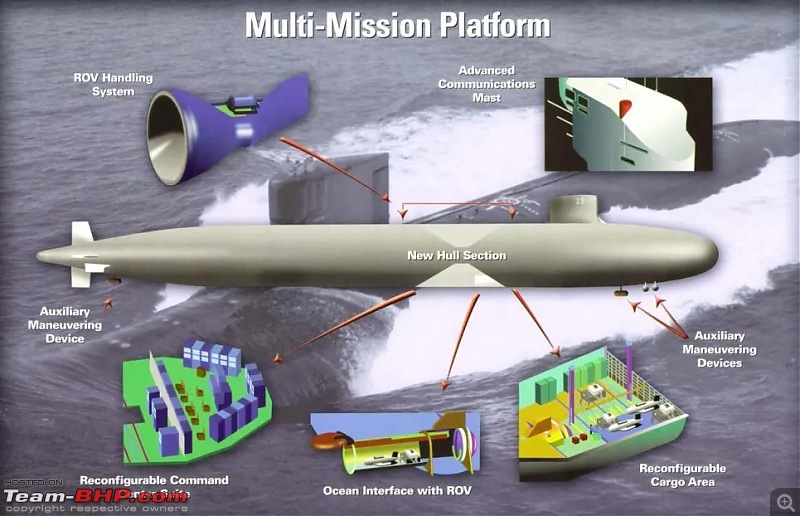 Source SourceQuote:
The Jimmy Carter is the tip of the spear when it comes to American undersea special missions capability with one of its infamous missions being tapping into undersea communications cables. You'd sure as hell want to make sure your hull plug holds up for such a sensitive mission. So yeah, basically it can be done on submarines. I guess if subs have had the entire nose revamped to say put in a new passive sonar dome or array, I guess it isn't that much of a stretch of the imagination to slice down the middle and add some extra length so to speak. I know when the reactor cores of decommissioned subs are disposed of, the scrapping crew cut into the hull but I wonder if during refuelling, there's some element of cutting open the pressure hull. Or perhaps to swap out a reactor core? I'm not sure if I'm correct on this last bit, I might be conflating the scrapping with the refuelling. | ||||
| |  (2)
Thanks (2)
Thanks
 |
| The following 2 BHPians Thank ads11 for this useful post: | Jeroen, V.Narayan |
| |
| | #197 | |
| Distinguished - BHPian  Join Date: Aug 2014 Location: Delhi-NCR
Posts: 4,071
Thanked: 64,335 Times
| Re: Submarines of the Indian Navy Quote:
| |
| |  (2)
Thanks (2)
Thanks
 |
| The following 2 BHPians Thank V.Narayan for this useful post: | ads11, Jeroen |
| | #198 | ||
| BHPian Join Date: Aug 2017 Location: Leeds
Posts: 938
Thanked: 2,259 Times
| Re: Submarines of the Indian Navy Quote:
One of my favourite reads about this particular German wunderwaffen and how the Allies got their hands on one: https://www.historynet.com/type-xxi-u-boat.htm Quote:
I will admit, this is a concern. It's a remarkably ambitious thing to be doing. Again, off the top of my head it looks like the Americans did it just the once and that's with their extremely experienced boatyards. India would be making the veritable hop, skip and giant jump here but come to think of it, it shouldn't be a surprise considering India's first domestic submarine effort was to build an SSBN (and then work backwards). In that light, sure. I can see why the IN planners didn't hesitate with this AIP modular add on plan. Let's hope it works because that'll be quite the achievement for domestic shipyards. | ||
| |  (2)
Thanks (2)
Thanks
 |
| The following 2 BHPians Thank ads11 for this useful post: | Jeroen, V.Narayan |
| | #199 |
| BHPian Join Date: May 2013 Location: Mumbai
Posts: 175
Thanked: 595 Times
| Re: Submarines of the Indian Navy Hopefully a further order 6 new Scorpenes is given to MDL to keep the production lines active till the indigenous Project 76 submarines enter production. The new tendering for Project 75I will take forever and that may risk the loss of abilities learnt during the production of Scorpenes. Improved Kalavari Class subs with DRDO AIP will be wonderful increment in our navy’s abilities to tackle regional threats, leaving the SSN’s free for strategic duties. |
| |  (1)
Thanks (1)
Thanks
 |
| The following BHPian Thanks DrPriyankT for this useful post: | V.Narayan |
| | #200 |
| BHPian Join Date: Aug 2017 Location: Leeds
Posts: 938
Thanked: 2,259 Times
| Re: Submarines of the Indian Navy Improved (ie, AIP equipped) Kalvari class cut out Have to enjoy a good cut out and here's one of the Kalvari class from HI Sutton as usual. 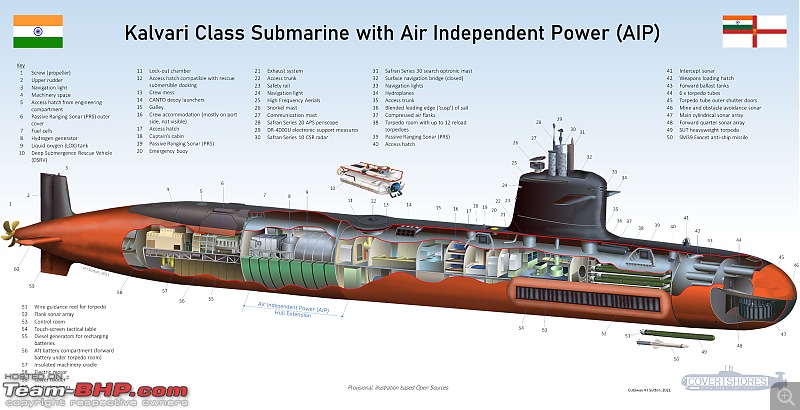 You can see the inclusion of the AIP module in this schematic. Also gives you an idea of the layout of the boat. What was interesting for me was seeing the cylindrical sonar array (see label 47) on the bow. I didn't expect it to simply be mounted like that, I suppose I was expecting it to be a whole set of panels arranged along the chin of the boat so to speak. Of course as the image caveats, this is based on open source data and in reality it could be different. Still was something new to me. Another thing I always wondered about were access hatches (see 5, 12, 17, 40) on submarines in general and this cut away gives a good idea of how they're interspersed throughout the boat. Particularly interesting to me was seeing the angled access hatch (see 42) at the top of the bow through which the torpedos and I expect cruise missiles too are slid down. Speaking about the Scorpene class derivatives, there's also a handy comparison graphic of the Brazilian, Chilean and Malaysian cousins of the IN's Kalvari class.  You'll notice here how the Brazilian boat is longer overall but as the schematic notes, it doesn't include the AIP module extension for the Kalvari follow on. To my knowledge I haven't come across how long this AIP extension would be but I would wager it brings the updated Kalvari's to within the overall length and displacement of the Brazilian boats. Sources: http://www.hisutton.com/Scorpene-Class-Submarine.html; https://twitter.com/CovertShores/sta...356032/photo/1 |
| |  (2)
Thanks (2)
Thanks
 |
| The following 2 BHPians Thank ads11 for this useful post: | dragracer567, V.Narayan |
| | #201 | |
| BHPian Join Date: Aug 2017 Location: Leeds
Posts: 938
Thanked: 2,259 Times
| Re: Submarines of the Indian Navy Quote:
For context, the French Rubis class nuclear attack boat Perle was badly damaged in a fire last summer while under refit. Burnt for 14 hours straight. Left the front half incredibly damaged. The original plan was to rebuild the nose but instead they took the nose section of the recently retired Saphir and used that to attach to the rest of the Perle, in the process causing the boat to grow a bit. You can find more details here for those interested. In this article they also mention how a US Los Angeles class nuclear attack boat, the USS San Francisco underwent a similar 'nose-job' repair after damaging its front end in a bad collision with a seamount. | |
| |  (3)
Thanks (3)
Thanks
 |
| The following 3 BHPians Thank ads11 for this useful post: | dragracer567, Jeroen, V.Narayan |
| | #202 | |
| Senior - BHPian Join Date: Apr 2011 Location: Pune
Posts: 1,155
Thanked: 1,956 Times
| Re: Submarines of the Indian Navy Quote:
I appreciate and thank you for such an informative write-up. I have two queries: 1. Submarine is a stealth weapon. Diving 50 meter deep shall be enough for visual stealth. Why do the boats need to dive to 100 m, 200 m, 400 m and even deeper? Do such depths help the sonar stealth due to thermoclines or heloclines? What is the benefit of having 400 - 500 m design depth over 200 m? 2. In future, if the boats could be detected over a long range (more than 50 - 100 km) will it be the end of submarines? Last edited by Rahul Bhalgat : 6th May 2021 at 01:18. | |
| |  (2)
Thanks (2)
Thanks
 |
| The following 2 BHPians Thank Rahul Bhalgat for this useful post: | dragracer567, V.Narayan |
| | #203 | |
| Distinguished - BHPian  Join Date: Aug 2014 Location: Delhi-NCR
Posts: 4,071
Thanked: 64,335 Times
| Re: Submarines of the Indian Navy Quote:
Last edited by V.Narayan : 6th May 2021 at 06:10. | |
| |  (5)
Thanks (5)
Thanks
 |
| The following 5 BHPians Thank V.Narayan for this useful post: | dragracer567, Kool_Kid, museycal, PetrolRider, Rahul Bhalgat |
| | #204 | |
| Distinguished - BHPian  Join Date: Aug 2014 Location: Delhi-NCR
Posts: 4,071
Thanked: 64,335 Times
| Re: Submarines of the Indian Navy Quote:
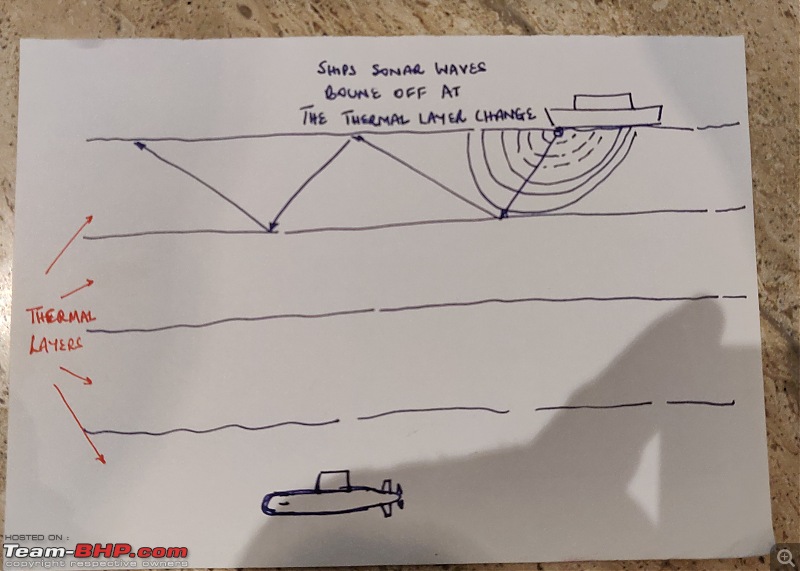 At 400 metres a submarine could have two or three or four such layers to hide beneath. The ASW ship on the surface has no way of knowing how deep the submarine is or in which direction or how far. To overcome this ships and helicopters use a variable depth sonar to put the sonar into (hopefully) exactly the same thermal band within which the submarines is cruising. This is especially effective from helicopters because a submarine cannot pick it up if it is operating in the passive sonar mode {ie only listening and not pinging}. Diagramme below. 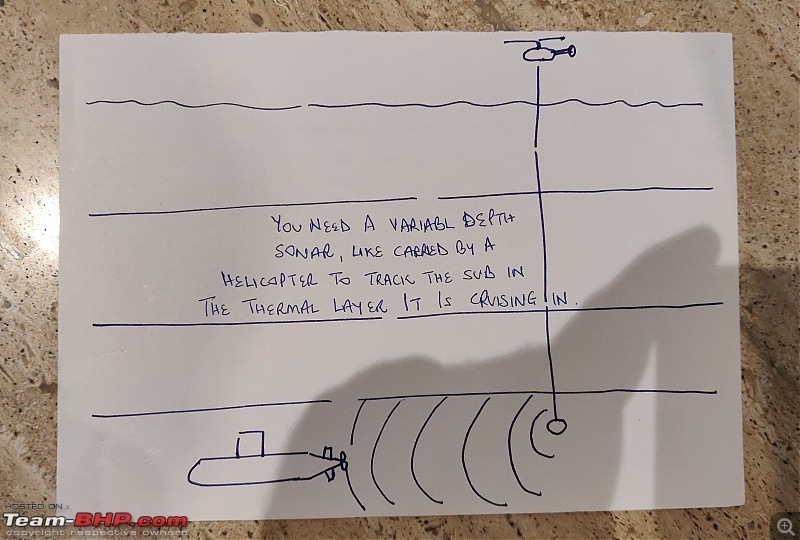 Think of each thermal layer as a cloak of invisibility for the submarine. For reasons I don't know the frequency range which ships propellers create sounds manage to travel through these thermal layers {life isn't fair}. As a consequence of all the above a submarine could hear a ship coming at 20 nautical miles while the ship at least through its active sonars might not pick up the sub at 2 nautical miles. Where passive search is concerned two helicopters working together could trap a sub. Could. Today's diesel electric boats like the Kilo or the Scorpene can have self-created noise at 4 knots lower than the ambient noise of the ocean. Dark cat in a dark room. Coming to your 2nd question. Water is transparent to noise with limits as described above and water is opaque to radar waves other than the ultra low frequency (ULF) spectrum. The latter can travel through water over long distances but its ULF nature does not lend it self to search and track. At best it can be used to communicate three or four digit coded messages. So as far as I know the technology to easily spot a submarine at 300 metres depth is no where in sight. Nothing of consequence even on the drawing board. Till then, at least for another generation or two or more the submarine will remain the ultimate stealth weapon. But it is not a one way street. Diesel electric boats which are the quietest when running on batteries must come up to charge their batteries. AIP has solved that to an extent but at the expense of complete quietness with the exception of the German Type 212. The nuclear boats as you know have speed and limitless range but at the expense of the noise of their pumps and turbines. Hope this helps. I am not a sailor let alone a submariner so my knowledge is limited to the theory I have read in my books. Members like @ads11 and @DrPriyankT, @Jeroen & @Maveryq can add more. Note to self- need to get back to class 7 and re-learn how to draw. Last edited by V.Narayan : 9th May 2021 at 21:21. | |
| |  (15)
Thanks (15)
Thanks
 |
| The following 15 BHPians Thank V.Narayan for this useful post: | ads11, badboyscad, dragracer567, DrPriyankT, Foxbat, Gannu_1, Jeroen, Keeleri_Achu, naveenvenkatesh, Rahul Bhalgat, sagarpadaki, Shreyans_Jain, skanchan95, torquecurve, Turbanator |
| | #205 |
| Distinguished - BHPian  | Re: Submarines of the Indian Navy Great drawing! Much appreciated! Even though submarine when submerged do not have a bow wave, they are displacing a lot of water. I seem to recall having read about a way of detecting this as well. So some sort of wave measuring technique that can distill a submarine displacement wave within the normal wave pattern. Obviously, the closer to the surface and the faster the sub is running the more likely this is to work. All with satellite imagery I seem to recall? Don’t know if it was just a conceptual idea or whether somebody has put it in practice? I believe both the Americans and Russian have a network of underwater microphones listening permanently for sub movement I believe. These would be below the regular thermo layers I guess? Something called sosas? Does depth play a role in this underwater microphone system? As I understand it’s not sonar, just very accurate microphones. Thanks Jeroen |
| |  (2)
Thanks (2)
Thanks
 |
| The following 2 BHPians Thank Jeroen for this useful post: | dragracer567, Rahul Bhalgat |
| | #206 | |
| Senior - BHPian Join Date: Apr 2011 Location: Pune
Posts: 1,155
Thanked: 1,956 Times
| Re: Submarines of the Indian Navy Quote:
As you have said, the depth enables the submarine to be hidden more effectively. And to counter this, the opponent can have variable depth sonar carried by a ship or a helicopter. And as Jeron has said, there could be listening systems permanently placed at various depths under water. Obviously, such systems would be placed only at the places of strategic importance; the whole sea / ocean won't be combed with these. So, even a deep diving submarine will be detectable at strategic locations (permanent listening devices) or where the opponent "expects or suspects it's presence" (variable depth sonar). So, will the submarines have a limited role in future, near strategically important areas? Will their role be limited mostly to the remote seas where they can really surprise? Actually, there may not be anyone there to surprise; the sub will just surface, fire a missile and vanish back into the depths. Will it be so? Last edited by Rahul Bhalgat : 9th May 2021 at 22:44. | |
| |  (2)
Thanks (2)
Thanks
 |
| The following 2 BHPians Thank Rahul Bhalgat for this useful post: | dragracer567, V.Narayan |
| |
| | #207 | |||
| Distinguished - BHPian  Join Date: Aug 2014 Location: Delhi-NCR
Posts: 4,071
Thanked: 64,335 Times
| Re: Submarines of the Indian Navy Quote:
All, The question assumes that information on Wikipedia or the English language part of Google is unbiased. The question indicates to me that we may first want to understand the sheer vastness of the oceans in three dimensions and we may want to not believe all that is written in Wikipedia. Forgive me if I can coming across strongly as that is not the intention. The starting point is to understand the complexity, underwater, in locating a sub, figuring out who it is (a very big if) and then tracking it long enough to determine direction, speed, range and then working out a firing plan and executing it. Even areas that seem narrow on a map, such as the Greenland-Iceland-UK gap, are actually vast. If everything works perfectly three ASW frigates and three ASW helicopters working in consort might take a few hours hours in the perfect case circumstance to complete all this. And this only when through some other means they know or believe an enemy submarine is in a given area of a few hundred square kms. And this assumes that all this while the submariner, who would have heard the enemy ASW frigates an hour or two in advance will not guess what's happening and will sail in a straight line waiting to be attacked. Hardly. Quote:
Quote:
In many circumstances a diesel electric boat sitting near the bottom can be impossible to detect with even active sonar. As land dwellers it is hard for us to fathom the many invisible sheaths of {submarine} invisibility formed by varying density and temperatures of the seas many strata - all this constantly changing from day to day and between day and night. SOSUS and other systems like it are tiny in their ability to locate, identify and track submarines relative to the size of the oceans or even the size of the Greenland-Iceland-UK gap. SOSUS was not perfect coverage nor did it work well 24 x 7 regardless of what Wikipedia {written by Americans} says*. Claiming to detect a Soviet Hotel class boat in 1962 passing through the Greenland-Iceland-UK gap from the US Coast over 2000 nm away may have happened - I don't know if it is true or propaganda. We don't know how often the Russians fooled or evaded SOSUS because the Russians rarely publicize this sort of information. And a Scorpene, U212 or even the venerable Kilo are over a hundred times quieter - literally - than the noisy Hotel. This is like saying that just because we have radar surveillance across the Pakistan border end-to-end no PAF aircraft can ever penetrate Indian airspace undetected. And using sound underwater to locate a submarine is way more more complex and confusing than detecting an aircraft by radar. If SOSUS was so perfect it begs the question why in the Cold War era and even today the American ASW forces are larger than the rest of the worlds navies combined.** Think about it. Hope this helps. * I am no expert on naval matters but I do know a little about aircraft. If I were to read only what the English language Wikipedia/Google wrote I would believe that every American and British military aircraft was top of the pops and most Russian or Chinese ones are full of faults. Neither is true. I take military matters on Wikipedia with a pinch of salt. I have yet to read on the net a list of the shortfalls of the Spitfire for example while I could name eight or nine from memory alone. **US Navy ASW aircraft+helicopters alone total ~740. The next 11 navies combined air arm devoted to ASW is ~730. If US Navy was so sure of SOSUS it would not need such a vast armada devoted to ASW when the Cold War has ended. And here we are only talking aircraft and not even counting the surface and sub-surface fleets. Last edited by V.Narayan : 10th May 2021 at 11:27. | |||
| |  (7)
Thanks (7)
Thanks
 |
| The following 7 BHPians Thank V.Narayan for this useful post: | dragracer567, Foxbat, Jeroen, naveenvenkatesh, PetrolRider, Rahul Bhalgat, skanchan95 |
| | #208 |
| BHPian Join Date: May 2009 Location: NYC / Lucknow
Posts: 620
Thanked: 3,549 Times
| Re: Submarines of the Indian Navy Another important instrument in locating submerged submarines are Sonobuoys A sonobuoy (a portmanteau of sonar and buoy) is a relatively small buoy - typically 13 cm diameter and 91 cm long - expendable sonar system that is dropped/ejected from aircraft or ships conducting anti-submarine warfare or underwater acoustic research. Sonobuoys are ejected from aircraft in canisters and deploy upon water impact. An inflatable surface float with a radio transmitter remains on the surface for communication with the aircraft, while one or more hydrophone sensors and stabilising equipment descend below the surface to a selected depth that is variable, depending on environmental conditions and the search pattern. The buoy relays acoustic information from its hydrophone via UHF/VHF radio to operators on board the aircraft/ship. 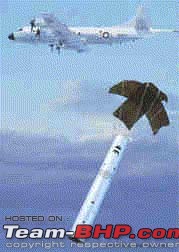 P-3 Orion paradropping a sonobuoy. |
| |  (3)
Thanks (3)
Thanks
 |
| The following 3 BHPians Thank Foxbat for this useful post: | dragracer567, Rahul Bhalgat, V.Narayan |
| | #209 | |||
| BHPian Join Date: Aug 2017 Location: Leeds
Posts: 938
Thanked: 2,259 Times
| Re: Submarines of the Indian Navy Quote:
Loved the line drawing for the sonar wave propagation - as anyone who works with seismic will tell you, or anyone learning Snell's Law even - them's the basics. 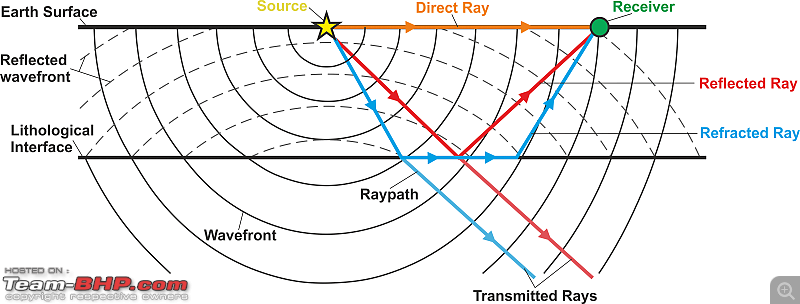 Simple line drawing showing how the sound waves reflect in a medium, shown here with a geological context (REF) 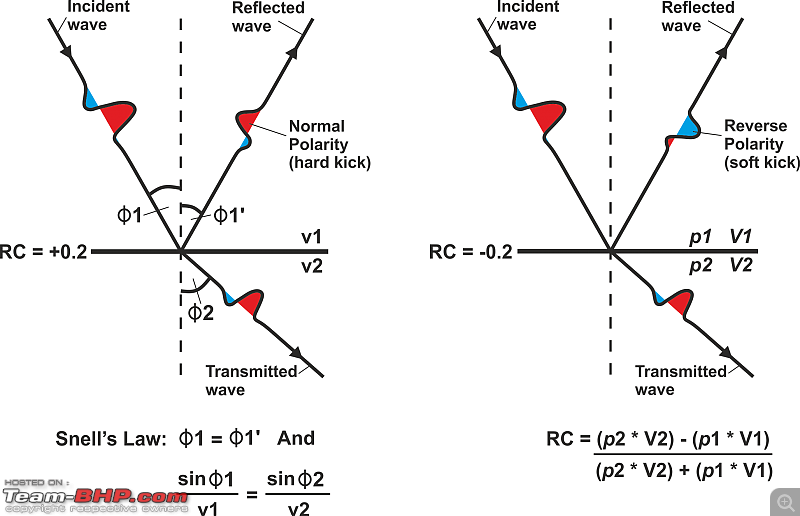 Snell's Law illustrated for those interested - if you find yourself really keen to go into a deep dive into seismic imaging I've linked the textbook chapter this is from. The principles with sonar imaging will be broadly consistent. (REF) Personally I work with sound waves being used to image the subsurface but I have to deal a fair bit with how they propagate in the water column and I'll try and add a little to the story there. As we know, the basic principle for using sound for imaging is essentially relying on the change in the velocity of propagation of our down going wave (direction is important because we get our returning waves coming back up), ie the change in the speed of sound, as it travels through material with ever so slightly different acoustic impedance. Acoustic impedance contrasts are key as what we essentially image are these interfaces where this property changes. Why this property might change is a variation of factors such as temperature, salinity, amongst others but principally it's the density contrast that is key here. 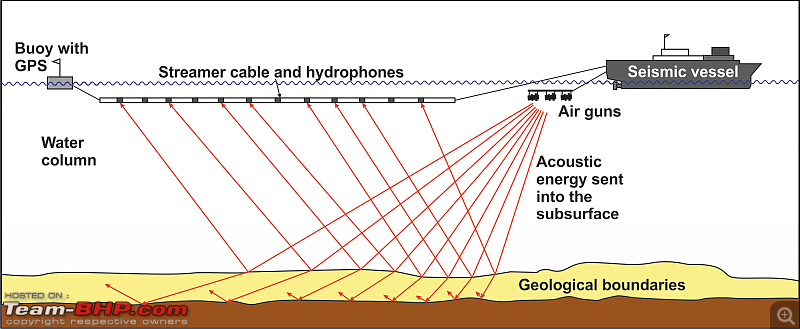 You can almost replace the seismic acquisition vessel here with an ASW warship and the streamer (listening device) with sonobuoys. In passive sonar applications used to hunt subs, you wouldn't need a sound source like the airguns in this example, however in active sonar there will be some kind of emitter. (REF) Now, as I mentioned above the temperature and salinity of the water column is key as that impacts its effective density, thereby creating layers so to speak. Broadly, when speaking of the thermal gradient of the water column we're referring to the thermocline, shown below. In essence, unless impacted by a bottom current carrying say colder Antarctic waters, the thermocline profile should be broadly consistent to this shape shown, with it possible to divide it into depth based bathymetric zones as follows (epipelagic up to 200 m; mesopelagic between 200 and 1000 m; and bathypelagic for anything below 1000 m). 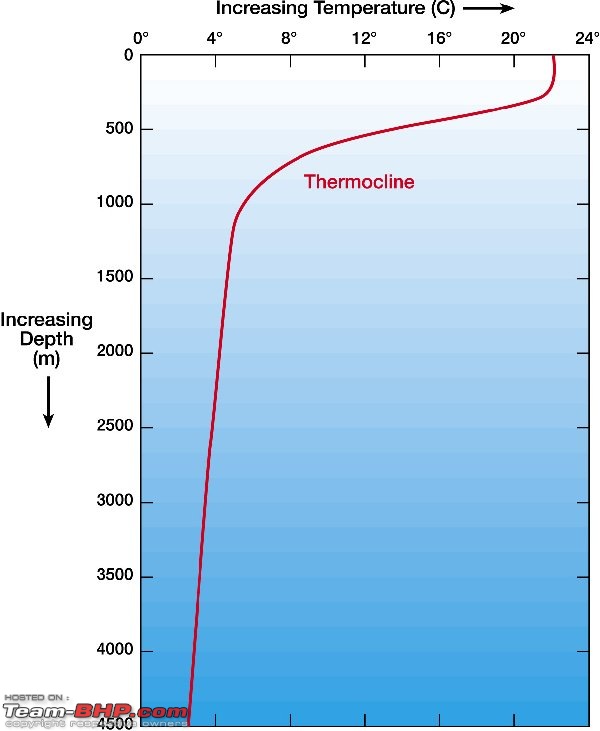 Example thermocline for a tropical setting. This can help give you an idea of the various thermal layers that V.Narayan alluded to in his schematic. Equally, salinity variations in the water column will create similar stratification and density contrasts, all of which contribute to requiring fiendishly complicated maths (talking Fourier transforms etc) to resolve the impact of these changes either scattering your sonar waves or dealing with noise in your returning signal Anyway, hopefully that was a brief but rudimentary primer on the physics involved. To answer your original question Rahul Bhagat, I'll double down just like V.Narayan did. Submarines aren't going anywhere. If anything they continue to offer the most cost effective means of creating an asymmetric threat. On the scale of the big boys, the submarine arm of the Russian Navy continues to keep that force relevant, with their latest arrival the Yasen-M class SSGN boat Severodvinsk proving to be one of the largest leaps the Russians have taken since Soviet times. In fact it's taken well over a decade for the Russians to field this modified version of their Yasen class nuclear attack boat. Going back to submarines, you see the deep secrecy with which India has shrouded the Arihant class; you see Pakistan wanting to equip their own AIP conventional boats with nuclear tipped cruise missiles and then there's the example of the Israeli's and the North Koreans already having their own second strike capability (Popeye cruise missiles on German designed boats for the former and crude SLBMs on archaic Soviet era boats for the latter). The story of how the Swedish Gottland class not only gave an entire US carrier group a tough time on an exercise it managed to score multiple hits on said carrier, impressing and alarming USN brass in such measure that they only went and leased the boat themselves to learn more. Basically undersea warfare is far from obsolete. As pointed out before, even with the SOSUS nets in the GIUK gap (anyone read Red Storm Rising by Tom Clancy? This would be all too familiar) - you still have Russian boats able to sneak past. Quote:
Quote:
| |||
| |  (5)
Thanks (5)
Thanks
 |
| The following 5 BHPians Thank ads11 for this useful post: | dragracer567, Foxbat, Rahul Bhalgat, sridhar-v, V.Narayan |
| | #210 | |
| Distinguished - BHPian  Join Date: Jan 2015 Location: Chennai
Posts: 1,824
Thanked: 8,478 Times
| Re: Submarines of the Indian Navy Quote:
I know how intercepts by air forces play out. Wonder how it works out in the ocean depths. | |
| |  (1)
Thanks (1)
Thanks
 |
| The following BHPian Thanks locusjag for this useful post: | dragracer567 |
 |


